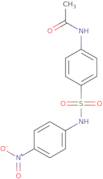Sulfanitran
CAS: 122-16-7
Ref. 3D-FS27938
| 1g | Discontinued | ||
| 2g | Discontinued | ||
| 5g | Discontinued | ||
| 250mg | Discontinued | ||
| 500mg | Discontinued |
Product Information
- 4'-[(p-Nitrophenyl)sulfamoyl]acetanilideN4-Acetyl-4'-nitrosulfanilanilideN4-Acetyl-N1-(4-nitrophenyl)sulfanilamide
- 4-(4-Nitrophenylsulfamoyl)Acetanilide
- 4′-[(p-Nitrophenyl)sulfamoyl]acetanilide
- Acetamide, N-[4-[[(4-nitrophenyl)amino]sulfonyl]phenyl]-
- Acetanilide, 4′-[(p-nitrophenyl)sulfamoyl]-
- N-[4-[[(4-Nitrophenyl)amino]sulfonyl]phenyl]acetamide
- N-{4-[(4-nitrophenyl)sulfamoyl]phenyl}acetamide
- N<sup>4</sup>-Acetyl-4′-nitrosulfanilanilide
- N<sup>4</sup>-Acetyl-N<sup>1</sup>-(4-nitrophenyl)sulfanilamide
- N<sup>4</sup>-Acetyl-N<sup>1</sup>-(p-nitrophenyl)sulfanilamide
- See more synonyms
- NSC 217299
- NSC 77120
- N4-Acetyl-N1-(p-nitrophenyl)sulfanilamide
- N4-Acetyl-N1-(4-nitrophenyl)sulfanilamide
Sulfanitran is a new antimicrobial agent that is structurally similar to the sulfa drugs. It is made of a sulfonamide group and a nitroimidazole group. Sulfanitran has been shown to be active against colorectal adenocarcinoma, as well as other types of cancer cells, in a biological sample. The activity of sulfanitran was tested using an electrochemical detector. This method showed that it had minimal toxicity, with little effect on cells or cell-cycle progression. Sulfanitran also showed antibacterial properties against Gram-positive and Gram-negative bacteria in wastewater treatment samples. It has been shown to be effective in the treatment of infectious diseases such as tuberculosis, caused by Mycobacterium tuberculosis. Furthermore, this drug has been used for the analysis of benzalkonium chloride and salinomycin sodium in bone cancer samples by LC-MS/MS (liquid chromatography tandem





